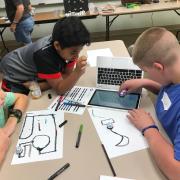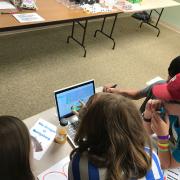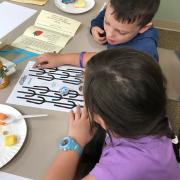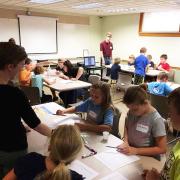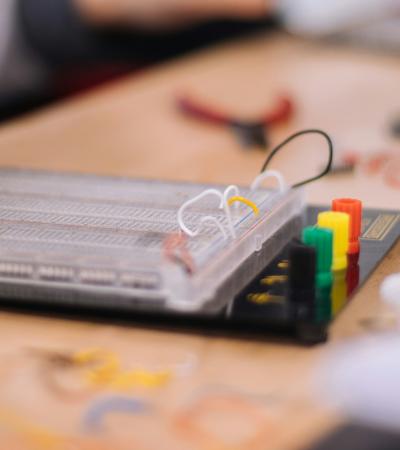Provide a half-day STEM camp where the kids really get involved and inspired.
Using STEM learning tools you already have, you can go deeper into a subject to reinforce knowledge that the students may have already been introduced to. Campers will have time to think about their tasks and fire up their minds and imaginations.
Advanced Planning
We want participants, many of whom attend regular library programming, to have extended time to experiment with and learn about STEM, so we offer these half-day camps. We set dates for our camps a month or so before school is out so that we can send general fliers into schools about them. Since we use STEM tools we have already used for programming, the planning goes quickly and is done by the end of the month before the program date.
Our goals are to get the participants really comfortable with STEM ideas and tools. The longer length of time of the camps gives kids the time they need to absorb the knowledge at their own pace.
Marketing
Our Outreach Services team goes into the schools every day during the school year. They take summer fliers into the schools before summer break begins.
We have a weekly feature in the local paper and submit a brief list of upcoming events about a month ahead. Then as programs get closer, we give complete details to the paper about two weeks out.
We also have signs in-house and send signs to the local public access channel. We list our events on community calendars on the web, in a weekly Chamber of Commerce e-newsletter, and send our program information to radios at the beginning of each month. (View a sample e-newsletter listing under Attachments.)
Budgeting
We use STEM tools that we already own, such as Ozobots, drones, virtual reality equipment, construction sets, circuitry sets, etc. We also buy a few things such as LED lights and batteries that are used to create something that the campers can take home.
We limit each session of BrainSTEM Camp to 20 campers and spend about $4 per camper on healthy snacks and a purchased boxed lunch. Considering how much the participants enjoy the camps and the fact that the three-hour camp period allows participants time to really think about and understand the STEM tasks given them, the cost is a real bargain.
Day-of-event Activity
This year's camps were held inside in our program room. We set up tables and chairs and placed start-up activities on each table. We had a large table at the front of the room where we placed the "camp" supplies that we would need as we progressed from one activity to another.
We set a limit of 20 students for each camp session. A minimum of two staff members to run the camp is essential, but three or four is even better and probably more fun for everyone involved.
Program Execution
We provide camp for two separate age groups. One camp is for students going into grades three through five, and the other is for students going into grades six through eight. This helps library staff when they select the STEM activities. We want the activities to be challenging but doable for each age group, giving each age group a sense of accomplishment when they’ve completed their goals.
Camp activities in the past have included an egg drop from the top of the library, designing and cooking in a solar oven, experimenting with 3D modeling and printing, creating a model car that moved by chemical reaction, and constructing hydraulic-powered cranes. This year we gave each of our camps a theme. This year’s themes were “Ozobot Survival Camp” for grades 3-5 and “Look to the Stars” for grades 6-8.
At “Ozobot Survival Camp,” participants were put into groups. Each group had their own Ozobots that were dropped into a specific landscape, including mountains, jungle, desert and plains. To survive in their landscape, the Ozobots had to blend in or use camouflage. To illustrate camouflage to the participants, we played several games. In one game real camouflaged animals had to be found in photos. In another game, yellow Skittles were placed in bowls of single color M&Ms. Each group was given 20 seconds to find all the yellow Skittles. The bowls were rotated from group to group, so that each group could see how much more difficult it is to find yellow Skittles in a bowl of yellow M&Ms.
After the camouflage games, participants designed camouflage for their Ozobots. Another element of the Ozobot Survival Camp involved crossing rivers using only the available items in each landscape to build a bridge. Before the bridge building began, participants performed tensile tests on paper to determine which shape provides the most strength under tension, providing information that came in handy during bridge-building. A third activity involved coding the Ozobots to perform various tasks.
During "Look to the Stars," the camp for older students, participants not only learned about circuits, they used their new knowledge to create a work of art for their room at home, designing and constructing their own light-up constellation.
Campers complete physical tasks, such as camouflaging Ozobots, building bridges, coding and creating a light-up constellation for their rooms, so we see physical results of given tasks. Parents express appreciation for the effort we put into the camps. The obvious enthusiasm and camaraderie among the campers is enough to keep us creating STEM camps for years to come. (View photos of camp participants under Photo Slideshow.)
Advice
Kids enjoy the idea of going to camp, so the idea of a STEM camp is an easy sell, especially when you throw in the words food and fun. This is the third summer where we’ve provided four sessions of BrainSTEM camps at our library. The kids never get tired of learning in this fun environment where they have time to think about the tasks they’re given and can expand their imaginations.
Planning is easy because you can do the same sorts of things at "camp" that you do at regular programming sessions. Two or three staff members can plan a three-hour camp in very little time. Be sure to make prototype camp projects ahead of time to test for difficulty. Staff will have almost as much fun as the campers.

